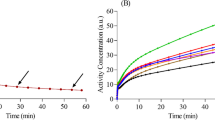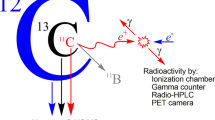Abstract
The conventional measurement of the regional cerebral metabolic rate of glucose (rCMRGlc) with fluorodeoxyglucose (FDG) and positron emission tomography (PET) requires arterial or arterialised-venous (a–v) blood sampling at frequent intervals to obtain the plasma input function (IF). We evaluated the accuracy of rCMRGlc measurements using population-based IFs that were calibrated with two a–v blood samples. Population-based IFs were derived from: (1) the average of a–v IFs from 26 patients (Standard IF) and (2) a published model of FDG plasma concentration (Feng IF). Values for rCMRGlc calculated from the population-based IFs were compared with values obtained with IFs derived from frequent a–v blood sampling in 20 non-diabetic and six diabetic patients. Values for rCMRGlc calculated with the different IFs were highly correlated for both patient groups (r≥0.992) and root mean square residuals about the regression line were less than 0.24 mg/min/100 g. The Feng IF tended to underestimate high rCMRGlc. Both population-based IFs simplify the measurement of rCMRGlc with minimal loss in accuracy and require only two a–v blood samples for calibration. The reduced blood sampling requirements markedly reduce radiation exposure to the blood sampler.
Similar content being viewed by others
References
Sokoloff L, Reivich M, Kennedy C, Des Rosiers MH, Patlack CS, Pettigrew KD, Sakurada M, Shinohara M. The [14C]de-oxyglucose method for the measurement of local cerebral glucose metabolism: theory, procedures and normal values in the conscious and anesthetized albino rat.J Neurochem 1977; 28: 897–916.
Phelps ME, Huang SC, Hoffman EJ, Selin MS, Sokoloff L, Kuhl DE. Tomographic measurement of local cerebral glucose metabolic rate in humans with (F-18)2-fluoro-2-deoxy-d-glucose: validation of method.Ann Neurol 1979; 6: 371–388.
Brooks RA. Alternative formulation for glucose utilization using labeled deoxyglucose.J Nucl Med 1982; 23: 538–539.
Hutchins GD, Holden JE, Koeppe RA, Halama JR, Gatley SJ, Nickles RJ. Alternative approach to single-scan estimation of cerebral glucose metabolic rate using glucose analogs, with particular application to ischemia.J Cereb Blood Flow Metab 1984; 4: 35–40.
Huang SC, Phelps ME, Hoffman EJ, Sideris K, Selin CJ, Kuhl DE. Noninvasive determination of local cerebral metabolic rate of glucose in man.Am J Physiol 1980; 238: E60-E82.
Kato A, Menon D, Diksic M, Yamamoto YL. Influence of the input function on the calculation of the local cerebral metabolic rate for glucose in the deoxyglucose method.J Cereb Blood Flow Metab 1984; 4: 41–46.
Phillips RL, Chen CY, Wong DF, London ED. An improved method to calculate cerebral metabolic rates of glucose using PET.J Nucl Med 1995; 36: 1668–1679.
Takikawa s, Dhawan V, Spetsieris P, Robeson W, Chaly T, Dahl R, Margouleff D, Eidelberg D. Noninvasive quantitative fluorodeoxyglucose PET studies with an estimated input function derived from a population-based arterial blood curve.Radiology 1993; 188: 131–136.
Iida H, Itoh H, Nakazawa M, Hatazawa J, Nishimura H, Onishi Y, Uemura K. Quantitative mapping of regional cerebral blood flow using iodine-123-IMP and SPECT.J Nucl Med 1994; 35: 2019–2030.
Iida H, Itoh H, Bloomfield PM, Munaka M, Higano S, Murakami M, Inugami A, Eberl S, Aizawa Y, Kanno I, Uemura K. A method to quantitate cerebral blood flow using a rotating gamma camera and iodine-123 iodoamphetamine with one blood sampling.Eur J Nucl Med 1994; 21: 1072–1084.
Huang S-C, Phelps M. Principles of tracer kinetic modeling in positron emission tomography and autoradiography. In: Phelps ME, Mazziotta JC, Schelbert HR, eds.Positron emission tomography and autoradiography: principles and applications for the brain and heart. New York: Raven Press; 1986: 287–346.
Hooper PK, Meikle SR, Eberl S, Fulham MJ. Validation of post injection transmission measurements for attenuation correction in neurological FDG PET studies.J Nucl Med 1996; 37: 128–136.
Huang S-C, Phelps ME, Hoffman EJ, Kuhl DE. Error sensitivity of fluorodeoxyglucose method for measurement of cerebral metabolic rate of glucose.J Cereb Blood Flow Metab 1981; 1: 391–401.
Feng D, Huang S-C, Wang X. Models for computer simulation studies of input functions for the tracer kinetic modeling with positron emission tomography.Int J Biomed Comput 1993; 32: 95–110.
Hunter GJ, Hamberg LM, Alpert NM, Choi NC, Fishman AJ. Simplified measurement of deoxyglucose utilization rate.J Nucl Med 1996; 37: 950–955.
Tamaki N, Yonekura Y, Kawamoto M, Magata Y, Sasayama S, Takahashi N, Nohara R, Kambara H, Kawai C, Konishi J. Simple quantification of regional myocardial uptake of fluorine-18-deoxyglucose in the fasting condition.J Nucl Med 1991; 32: 2152–2157.
Author information
Authors and Affiliations
Rights and permissions
About this article
Cite this article
Eberl, S., Anayat, A.R., Fulton, R.R. et al. Evaluation of two population-based input functions for quantitative neurological FDG PET studies. Eur J Nucl Med 24, 299–304 (1997). https://doi.org/10.1007/BF01728767
Received:
Revised:
Issue Date:
DOI: https://doi.org/10.1007/BF01728767




